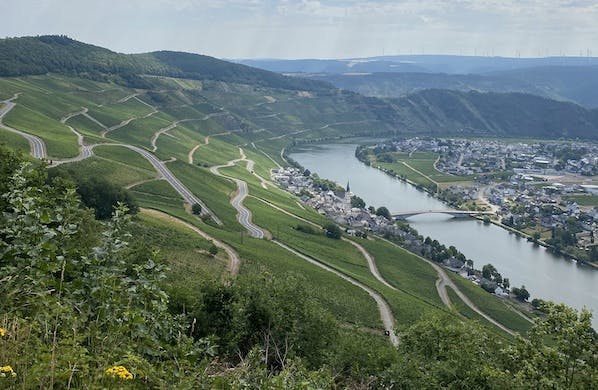Pleasant Surprise for Wine Drinkers: Another Great Vintage in Germany
Everything changed at the last minute for Mosel Riesling, and the results far exceeded anyone’s expectations. What they ended up with was a gorgeous set of wines.

Climate change in all its unpredictability has been throwing curveballs at vintners around the world. In a marginal continental climate, like Germany, warming temperatures have allowed for better vintages more often than the historical average. Yet the weather patterns — their timing, frequency, and severity — bear little resemblance to what was considered normal. These fluctuations have affected the wines being crafted and confounded everyone involved in their production and consumption.
This is especially true for wines made from Riesling in the Mosel in a vintage like 2022. Last year, for the majority of the season, the hot, dry weather had everyone assuming wines would be full bodied, low acid, and fruity, similar to those of 2018. Wines like this are not bad, but they do lack the finesse, lighter body, and higher acid typical of the region.
August rolled around and the earliest harvest in German history started. Producers were worried they would have to choose between two bad options: Pick grapes early at moderate sugar levels for freshness and lower alcohol levels but lacking phenolic (skin/flavor) development, or wait for more flavor and risk making clunky, dense wines. Both are missing the complexity, minerality, and sense of place that make Mosel Riesling so unique and desirable.
Everything changed at a critical moment, after the harvest had started for reds and non-Riesling grapes, but just in time for the resulting Riesling wines to far exceeded anyone’s expectations. What they ended up with was a gorgeous set of wines: pure, bright, elegant, easy to drink, with a clear sense of place, showing precise minerality, and enough concentration to age. The balance winemakers thought they’d be lacking arrived on a tightrope, bright and easy to drink, lithe and flavorful. After all the hand wringing and doom and gloom predictions, we are all about to be treated to great wines.
Part of the confusion as to the wines this year is a newish and expanding definition of “low quality” for German wines. Acid in wines here was always a given, a detriment in all those bad years. So it was ripeness, defined by the amount of sugar present in grape must (juice from fresh grapes before fermentation) at harvest, which was prized above all else. It was even codified into law in 1971 with the quality classification system.
That system divided wines into two main categories: Those that didn’t have a high enough sugar level are labeled Qualitätswein (Qba) and those that did are bumped up into the Prädikatswein, or “superior quality wine.” Neither scale judges wines based on their actual quality attributes — such as balance, concentration, complexity, finesse, intensity, integration, age-worthiness, or length of finish — but simply on their must weight.
Until 30 years, average temperatures were too cold to consistently bring grapes to full ripeness every year, and only three in a decade were considered good or great. Sugar accumulation alone shouldn’t be the deciding factor if a wine is good, but the fact is that wines at the top of the scale were fetching the highest prices. They were often made in the lowest quantities and farmers took a risk leaving bunches on the vine, inclement weather or disease could destroy the remaining, most valuable crop.
Many producers at the QbA level avoided risk and resorted to adjustments. Either chaptalization, or adding sugar to fermenting must to boost finished alcohol levels for more body, or blending in süssreserve, sweet grape juice held back at harvest, was used to temper the raging acidity levels of underripe fruit. Neither method improves the quality, just the general drinkability, and in fact both are illegal in Prädikat wines.
Now, things are flipped. It’s the acidity that is missing from the equation. Too much or little of a good thing, acid, can make wine unbearable. Too much, as was the historical problem, and you get wines that are too tart, sharp, akin to lemon juice or even battery acid. Now, especially in recent hot vintages like 2018 you are faced with high sugar levels, dropping acidity and with less than ideal phenolic ripeness for unbalanced wines.
So what happened that yanked these 2022 wines into the great category?
First, though I haven’t got anyone to confirm this hypothesis, I think that the heat and lack of water shut down ripening during the hottest times. This meant sugar wasn’t accumulating as quickly as it could have been were it slightly less hot, or even wetter.
Then, even though harvest did commence earlier than ever before, the skies opened up with a gift from above. Rain, the first in three months, paused the Riesling harvest, giving grapes much needed water and an extra couple of weeks of phenolic ripening. Nights cooled down, which helped to keep the acidity high and refreshing. Then, days cooled down as well, pushing harvest till the end of October for some, making it one of the longest harvests for many properties.
Predicting harvests or quality of wines has always been a fool’s errand. But with an ever changing atmosphere the possibilities of what to expect and how to manage farming to handle those expectations is more difficult than ever. For this current year at least, we’ve got some great wine to look forward to.

